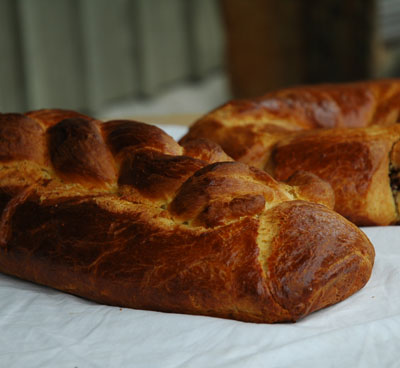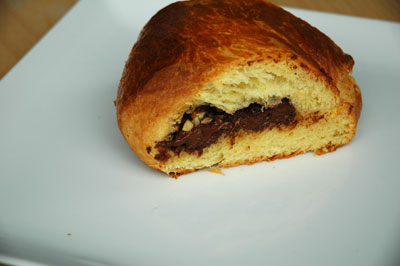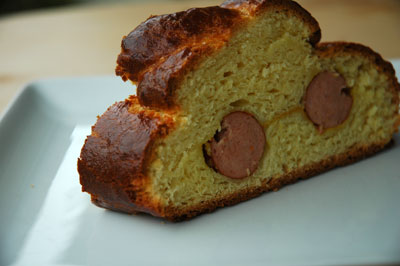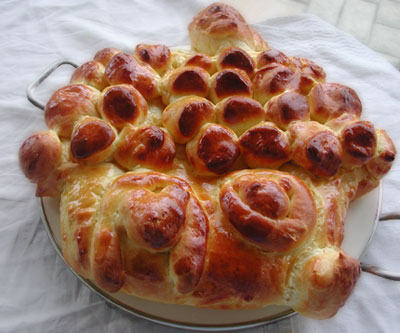Fun With Brioche Dough

Brioche bread is so delicate, light and buttery that is just one tiny step removed from being a pastry. Plain brioche bread is delicious on its own, toasted or with loads of jam. But brioche dough also makes an ideal casing for all kinds of fillings both savory and sweet. It's my favorite dough for making anything en croute, as well as for sweet filled breads that are so nice for a brunch party.
Here I would like to introduce you to two types of filled brioche. One is a party-sized pain au chocolat of sorts; brioche dough filled with dark chocolate and chopped hazelnuts, then shaped into any kind of shape that strikes your fancy. (A traditional pain au chocolate (which literally means 'chocolate bread' is a small bread, usually made of croissant dough though I've seen other buttery doughs used, and filled with chocolate.) It's really perfect for a brunch party, and makes a great alternative to a traditional cake at a childrens' party. Here's a slice that shows the still-meltingly soft chocolate inside. The dark chocolate marries so well with the golden tenderness of the brioche.

The other is a brioche loaf filled with a little mustard and one or two fat, garlicky sausages. The one in the photograph here is topped with a simple braid, but again you can make this into any shape you like. It's a great picnic bread or buffet-party item. For the one here, I put in two sausages since that's what I had on hand, and it unintentionally came out looking like a little car.

I made the brioche-house pictured here for Easter. I put two little bunny heads on the house (one is peeking from the door, the other around the side), but they ended up looking just like lumps. Nevertheless, the house was a huge hit. It's filled with a mixture of dark and light chocolate.

Unlike other kinds of bread, I've never had a problem making brioche. The one thing to remember about brioche dough is that it is loaded with butter, just like a pastry dough. Therefore, it is best handled cool. This means that you need to give it plenty of time, and to let the dough rise in the cool of the refigerator over several hours, preferably overnight. If you are planning to serve your brioche at a Sunday brunch, start the process on Saturday morning. If you're new to bread baking, this probably goes against just about everything you've read about raising bread at a warm temperature and so on, but yeast does it work at cool temperatures too - just at a slower pace. Proofing the dough in the refrigerator gives you a smooth, workable dough, with little pockets of butter all throughout.
I make brioche with a food processor; this has the advantage of keeping all the ingredients relatively cool, as opposed to hand-kneading which transfers your body heat to the dough. I just do the final kneading parts by hand. You can also use a dough mixer or mix by hand of course, and I have given instructions for both the food processor and hand methods. If at any point the dough gets too gooey-buttery and soft, just put it back in the fridge until it's cool enough to handle again.
The following recipe is adapted from one of my kitchen bibles, Julia Child's The Way To Cook. The one main change is that I use bread flour with a higher gluten content, to give the crumb more body than can be achieved with regular all-purpose flour. (In Switzerland, I use Zopfmehl.) This makes enough dough for one large loaf - or, 1 chocolate ring OR 1 sausage bread. If you want to make both at the same time, double the recipe. You may need to make a large amount of dough in two batches.
Brioche Bread
For the dough:
- 180g / 6 oz (approximately 1 1/2 sticks if you're in the U.S.) unsalted butter
- 1 package (7g) dry yeast
- 1/4 cup lukewarm water
- 1 pinch sugar
- 3 1/2 cups bread flour, give or take about 1/4 cup
- 1 1/2 tsp. salt
- 1/3 cup sugar (more if a sweeter dough is desired)
- 4 large eggs
- 1/3 cups whole milk or light cream
For the chocolate-nut ring:
- 200g / 7 oz. dark chocolate chips
- 60g / 2 oz roughly chopped hazelnuts (you can use any other kind of nuts you like)
For the braided sausage bread:
- 1 or 2 sausages of your choice - a Lyon style garlicky sausage or the type that's called a 'summer sausage' works well here. A hard dried sausage such as salami doesn't.
- 2 Tbs of Dijon-style mustard
For the egg wash / glaze:
- 1 egg
- 1 Tbs. milk
Preparation: Cut the butter into small dice, spread out onto a plate, and put in the freezer until it's very hard but not quite frozen.
Proof the yeast: Mix together the yeast, lukewarm water and pinch of sugar. Leave until the yeast gets foamy.
In a large bowl or in the bowl of your food processor, mix together the flour, 1/3 cup sugar and salt. Add the butter cubes, and if using a food processor pulse until the flour mixture becomes grainy. If mixing by hand, mix together with your hands by grabbing and rubbing until it becomes rather grainy. (You can also use a pastry blender for this, but I find that the hands work best.)
In a separate bowl, mix together the proofed yeast, beaten eggs, and milk or cream. Add in batches to the flour mixture while the food processor is running (or if by hand, mix vigorously with a wooden spoon.) When you're done you will have a rather shaggy looking ball of dough. Put the bowl in the refrigerator, and let it rest for about 10 minutes.
Take out the bowl, and turn out onto a floured surface. Knead it rapidly, pushing and turning, adding sprinkles of flour if needed, until you have a fairly smooth ball. Put this into a clean bowl, cover with plastic wrap or a plate, and leave to rise for about an hour.
 Punch down the dough ball, and put the ball into a plastic bag that's big enough to allow the ball to expand to at least 3 times its original size. Suck out as much air out of the bag as you can, seal tightly and then put the whole into another plastic bag, and place in the refrigerator. Leave it there for at least 4-5 hours, preferably overnight or more. Making the dough up to this point the day ahead of when you want to bake it makes the most sense. You can leave it a maximum of 3 days. During this time, you will find that the dough will rise and almost burst the bag open, so you will need to periodically take a look at it and punch it down. This is why double-bagging is a good idea, since you may accidentally puncture the bag while punching it too hard.
Punch down the dough ball, and put the ball into a plastic bag that's big enough to allow the ball to expand to at least 3 times its original size. Suck out as much air out of the bag as you can, seal tightly and then put the whole into another plastic bag, and place in the refrigerator. Leave it there for at least 4-5 hours, preferably overnight or more. Making the dough up to this point the day ahead of when you want to bake it makes the most sense. You can leave it a maximum of 3 days. During this time, you will find that the dough will rise and almost burst the bag open, so you will need to periodically take a look at it and punch it down. This is why double-bagging is a good idea, since you may accidentally puncture the bag while punching it too hard.
About 90 minutes before you want to bake the bread, take the dough out and shape and fill it as you wish. Here I have shown how to make the chocolate and hazelnut-filled ring. The dough is rolled out into a long flat sausage, filled with the chocolate and nuts, shaped into a ring, then cut all around with a pair of kitchen scissors, to form a sort of flower shape. (You could fill this with dried fruit, or a cinnamon-sugar mixture, or whatever strikes your fancy). For the sausage bread, roll out the dough into a rough rectangle (reserving about 1/3rd of the dough), spread with the mustard, place the sausage and roll up the dough, pinching the seam tightly to seal. Cut the remaining dough into three pieces, stretch out and braid to put on top. After you've shaped the dough to your liking, place it on a parchment or silicon pad lined baking sheet and cover with another piece of parchment paper (not plastic wrap, which tends to stick to the dough and tear it when you try to take it off). Leave in a warm place until about doubled in bulk. 20 minutes before you intend to start baking, switch on the oven to 180°C / 350°F.
Brush the top of the dough with an egg wash (a mixture of beaten egg and a little milk) and bake for about 45 to 50 minutes - a longer time if you are baking 2 at once, shorter if you have a convection oven. Start checking at around 40 minutes; it should look dark golden brown and a bit crispy.
Take out and let cool, and enjoy.
If you enjoyed this article, please consider becoming my patron via Patreon. ^_^

 Welcome to Just Hungry, where we serve authentic Japanese recipes and more! I'm
Welcome to Just Hungry, where we serve authentic Japanese recipes and more! I'm 












Comments
gidget bananas
3 June, 2006 - 22:57
Permalink
Fun With Brioche
Ohhhhh, I so want to try making chocolate hazel nut brioche. Sounds like diet food to me!
From Our Kitchen
4 June, 2006 - 07:28
Permalink
Fun With Brioche
Your brioch looks wonderful! I've been wanting to make this for a very long time. When I finally get around to it I will have to try your chocolate filling idea.
roanne
4 June, 2006 - 18:42
Permalink
Fun With Brioche
Great text and photos. A couple of questions. Do you know the French translation of the four you use (it should be on the bag)? I have never been able to figure out what "strong" flour is in French so don't know what to ask for here in Lausanne.
Have you tried making the brioche without sugar? In France you can find it sugarless and in loaves - perfect with foie gras. I tried adapting a recipe to make a sugarless version but the brioche was too dense.
Tanna
17 June, 2006 - 06:30
Permalink
Fun With Brioche
Your picture are very beautiful and also very illustrative! Excellent. One day I will make brioche.
maki
18 June, 2006 - 21:47
Permalink
Fun With Brioche
Roanne, I don't have a bag handy at the moment, but look for "farine pour tresse" in Lausanne. It should have a picture of a loaf of tresse (braided bread for the non-Swiss residents) on the bag. I think you need a bit of sugar in the dough to make the yeast activate better, but by using stronger flour it should have more body (but I haven't tried it though so...)
roanne
19 June, 2006 - 09:37
Permalink
Fun With Brioche
Thanks! I know the "farine de tresse" - just thought you could only make it for "tresse" bread. Globus has loads of different flours but most of them only have a description in German (I had always thought that, by law, all food had to be labelled in the three official languages). Will try another brioche using your recipe (will cut down on sugar). Glad to see you back!
lina
19 January, 2007 - 14:21
Permalink
Fun With Brioche
hi, i live in AUstralia, would i have to convert the measurements with all the recipes you have ?
maki
19 January, 2007 - 16:25
Permalink
Fun With Brioche
I mostly try to include both metric and pound/oz measurements. Sometimes I use 'cups', which are American cups - so one cup = 240ml. Hope that helps!
Kogepan
9 March, 2007 - 21:44
Permalink
Flour
can you substitute bread flour for normal or whole wheat flour?
maki
9 March, 2007 - 23:04
Permalink
brioche flour substitutions
You can try white bread flour instead of all-purpose; the results may be a bit different but should be fine. I wouldn't use whole wheat flour in this recipe though, the texture would be totally different.
joyce
18 September, 2007 - 10:24
Permalink
flour
are brioche's actually bread. and can I use a mixture of white and whole wheat flour to get a better texture? and please do tell me what is bread flour?
odesey7
4 October, 2007 - 23:24
Permalink
bread flour
Bread flour is a high-gluten flour that has very small amounts of malted barley flour and vitamin C or potassium bromate added. The barley flour helps the yeast work, and the other additive increases the elasticity of the gluten and its ability to retain gas as the dough rises and bakes.
anon.
29 April, 2008 - 01:36
Permalink
Dough wont rise
I followed this recipe closely. I mixed everything by hand (cold butter into the flour mix) then I used a mixer (with a flat beater) to integrate the wet/dry. However after refrigerating the dough it did not rise any further (it rose about 50% in the resting step prior).
I know this isn't a lot of information to go by, but can you suggest possible missteps or advice on dough that wont rise?
Thanks!
maki
29 April, 2008 - 06:33
Permalink
hmm, the only thing I can
hmm, the only thing I can think of is that the yeast was not viable enough. Did it foam up a lot when you proofed it? (the initial mixing with the warm water etc.) With this dough I usually have the opposite problem - it rises so much that I have to punch it down to hold it back!
Donovan
1 March, 2009 - 20:44
Permalink
Re: Fun With Brioche
I just made these today and they have a lovely delicate flavor. I think I will add more flour breadcrumbs next time because they did not keep their shape very well and ended up looking pretty sad ! The mixture would make a nice dip too. Thank you.
Noah
2 March, 2009 - 12:42
Permalink
Re: Fun With Brioche
Though your blog is called "just hungry" it is indeed not for those who are hungry!))) I opened your page yesterday on an empty stomach... you know, I thought that I would go mad... so I decided to take some receipts after eating) So, now, after a nice dinner I can peacefully search for what seems to be tasty!
mew
11 April, 2009 - 02:50
Permalink
Re: Fun With Brioche
undying-afortiori.blogspot.com/2008/05/brioche-pastry-bread.html
I think that's your picture....
maki
11 April, 2009 - 03:32
Permalink
Re: Fun With Brioche
Yep, it sure is. :(
ewan
28 April, 2009 - 16:07
Permalink
Re: Fun With Brioche
can anybody tell me what the chocolate filled brioche is called in scotland. one of my friends says 5ts ca33ed something there but cant remember what it is
Navita Hakim
15 July, 2009 - 11:01
Permalink
Re: Fun With Brioche
Hi there...my first time here. Was googling for brioche dough styles....yours look amazing. Just one question..how did u manage to braid the 'sticky' dough...I can't :(
Help plz I am making it for my bro as a surprise.
maki
16 July, 2009 - 10:31
Permalink
Re: Fun With Brioche
The key to working with brioche dough is to keep it as cool as possible. So if it starts to get sticky/gooey/buttery, stick it in the refrigerator for an hour or so to cool it and firm up the butter again. Good luck - your brother is so lucky! :)
mal
4 September, 2009 - 02:14
Permalink
Re: Fun With Brioche
I just used your recipe for a potluck and it was sensational! Thank you for this marvelous (albeit rather time-consuming) recipe! I had a lot of fun baking this and your instructions were very helpful.
The only things I would say is that, for me, the baking time was about 10 minutes less than your minimum (40 minutes). Perhaps this is just a difference in oven types or something but it's a good thing I checked or it might have burned! =) Also, I was a bit worried at first because the dough wasn't rising as much as you said it would (in fact, it didn't rise at all after I placed it in the fridge) but, when I left it out after I shaped it, it rose quite nicely. Is there a reason for this?
I will definitely use this recipe again and I look forward to experimenting with the other recipes you have on this site! (The onigiri sounds particularly good...)
Thank you again!
C. Brown
19 July, 2010 - 07:55
Permalink
Pain au Chocolat
The recipe worked extremely well - at least for American palates. I used almost all my Ghiradelli dark chocolate chips (so at least 11 oz!), and the bread was well-loved by all (except one who does not like dark chocolate).
Note: the dough going in and coming out of the fridge was more like a very thick batter. However, using a lot of flour while kneading worked quite well.
Most definitely recommend!
Reece
16 November, 2011 - 03:44
Permalink
Re: Fun With Brioche
Wonderul recipe, everyone loved it. I added a bit more sugar to the dough and it turned out amazing. Chocolate and bread never tasted so good before.